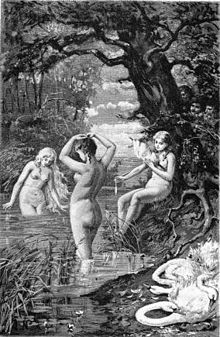This article may be too long to read and navigate comfortably. When this tag was added, its readable prose size was 30,000 words. (June 2023) |

The "swan maiden" story is a name in folkloristics used to refer to three kinds of stories: those where one of the characters is a bird-maiden, in which she can appear either as a bird or as a woman; those in which one of the elements of the narrative is the theft of the feather-robe belonging to a bird-maiden, though it is not the most important theme in the story; and finally the most commonly referred to motif, and also the most archaic in origin: those stories in which the main theme, among several mixed motifs, is that of a man who finds the bird-maiden bathing and steals her feathered robe, which leads to him becoming married to the bird-maiden. Later, the maiden recovers the robe and flies away, returning to the sky, and the man may seek her again.[1][2] It is one of the most widely distributed motifs in the world, most probably being many millennia old,[1][2][3] and the best known supernatural wife figure in narratives.[4]
It also belongs to the larger motif of the "Magic Wife",[3] pertaining to the index category ATU 400, "The Man on a Quest for His Lost Wife", where the man makes a pact with a supernatural female creature, which later departs.[2] This category is one of the most interconnected and centrally referred to among all the other stories, for instance along with the Dragonslayer motif.[2][5] More generally, it is also called the bird-maiden or sky-maiden motif, since not always they are swans: the properly called swan maiden appear in stories of the northernmost regions, in which they are part of a group where the bird-maidens are migratory birds, among other variants, such as the goose, duck, crane and heron. The sky-maiden may also appear in other stories as doves, non-migratory birds, and also as stars or celestial nymphs.[1][2][3]
The literal swan maiden character in particular is a mythical creature who shapeshifts from human form to swan form.[6] The key to the transformation is usually a swan skin, or a garment with swan feathers attached.[7][8] In folktales of this type, the male character spies the maiden, typically by some body of water (usually bathing), then snatches away the feather garment (or some other article of clothing), which prevents her from flying away (or swimming away, or renders her helpless in some other manner), forcing her to become his wife.[9]
There are parallels around the world, notably the Völundarkviða[10] and Grimms' Fairy Tales KHM 193 "The Drummer".[9] There are also many parallels involving creatures other than swans.
- ^ a b c Hatto, A. T. (1961). "The Swan Maiden: A Folk-Tale of North Eurasian Origin?". Bulletin of the School of Oriental and African Studies, University of London. 24 (2): 326–352. doi:10.1017/S0041977X00091461. ISSN 0041-977X. JSTOR 610171.
- ^ a b c d e d’Huy, Julien (10 April 2023). "Compte de faits : ou comment les statistiques peuvent venir en aide à la mythologie comparée". Revue des langues romanes (in French). 1 (1). doi:10.4000/rlr.5479. ISSN 0223-3711.
- ^ a b c Berezkin, Yuri (2010). "Sky-Maiden and World Mythology". Iris (31): 27–39. doi:10.35562/iris.2020.
- ^ Edmunds, Lowell (28 April 2020). Stealing Helen: The Myth of the Abducted Wife in Comparative Perspective. Princeton University Press. ISBN 978-0-691-20233-4.
- ^ d'Huy, Julien (2019). "Folk-Tale Networks: A Statistical Approach to Combinations of Tale Types". Journal of Ethnology and Folkloristics. 13 (1).
- ^ Bäcker, Jörg. "Schwanjungfrau". In: Enzyklopädie des Märchens Band 12: Schinden, Schinder – Sublimierung. Edited by Rudolf Wilhelm Brednich; Hermann Bausinger; Wolfgang Brückner; Daniel Drascek; Helge Gerndt; Ines Köhler-Zülch; Lutz Röhrich; Klaus Roth. De Gruyter, 2016 [2007]. p. 311. ISBN 978-3-11-019936-9.
- ^ Beaumont, C. W. (1952). The Ballet called Swan Lake. London: Beaumont. p. 36.
- ^ Stuart-Glennie, John S. (1968). "Incidents of Swan-Maiden Marriage". In Richard M. Dorson (ed.). Peasant Customs and Savage Myths. Vol. II. The University of Chicago Press. p. 523.
[In "The Swan-Maiden Marriage"] the maiden is represented as of a higher race than, or at least different race from, her suitor, and particularly as wearing clothes, and often, though not generally, a feather dress.
- ^ a b Thompson (1977), p. 88.
- ^ Thompson (1977), 88, note 2.